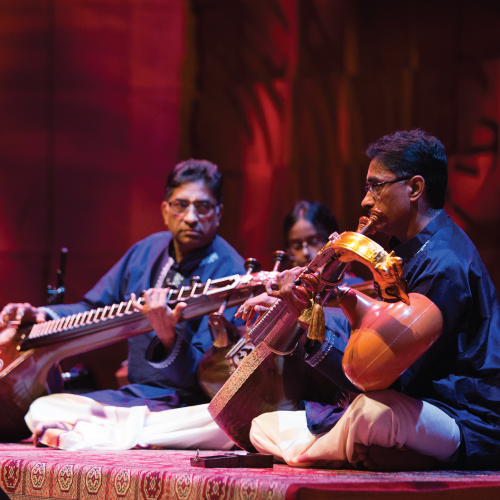
The renowned Iyer Brothers celebrate 50 years of playing the veena together
The Iyer Brothers are set to share personal musical stories of their journey with the veena in Elisabeth Murdoch Hall on Tuesday 26 September, accompanied by an impressive ensemble of veena players and featuring voices of the brothers’ young Australian students.
We spoke with the Iyer Brothers, Ramnath and Gopinath Iyer, ahead of their performance to learn a bit more about the curious string instrument they have spent a half-century mastering.
What makes the veena such a unique instrument?
The veena is one of the most ancient string instruments of India. It is a delicate, beautiful instrument that, in the hands of a master, can express all the nuances of Carnatic vocal and instrumental music. The veena has a unique tonal quality due to its construction, starting with a bass sound in the lower octaves and shriller tones in the higher octaves, very similar to the human voice.
Could you explain the historical significance of the veena and its role in traditional Indian music and culture?
The veena has a recorded history that dates back to the Vedic period (approximately 1500 BCE) and is referenced in ancient works such as the famous Tamil literary work Silappadikaram (approximately 2nd Century AD). There were even beliefs stated in these ancient texts that the veena eradicates all evil and bestows great good on people, just through listening to its notes, developing a cultural reverse for the instrument that endures today.
The veena is also referred to as the ‘Saraswati veena’, named after the Hindu goddess of wisdom and arts Saraswati - who is usually depicted holding or playing the instrument. Veena music is frequently performed in temples as offerings to the Gods and Goddesses and in times gone by, veena players were employed as court musicians in the royal palaces of the South Indian kingdoms. They would play for the enjoyment of the royal families and other members of the king’s court including on special occasions and for royal visitors and guests.
The science and grammar of Indian music was developed and codified over the ages using the veena as a reference instrument, with Muthuswamy Dikshitar, one of the most famous composers from the 18th Century, using the veena as a reference to write his compositions which continue to form a core part of the repertoire in veena music today.

In what ways has the veena evolved and adapted over time to fit into modern music contexts while preserving its traditional essence?
There have been several technological advancements done to the construction of the veena over the years. These include evolution in construction materials, the size of the instrument and sound amplification of the veena.
In the modern context, for a veena concert to make an impact in a large concert hall, the instrument needs to have the throw and power of a human voice but as a soft string instrument, it requires strong amplification to reach out to audiences. Striking a balance between amplification of sound whilst maintaining the purity and beauty of the tone of the instrument is a challenge that today’s artists and sound engineers face. In the 1970s contact microphones were invented and have been gratefully used by veena artists to make their concerts successful, while more recently modern electronic gadgets such as pre-amplifiers, sound mixers and the revolutionary electronic veena have innovated the sound amplification of the veena.
The art of making the veena is a rare skill that is preserved by traditional artisans in South India. As such, each instrument is precious, has its own individual tonal quality and character and can only be repaired by a master in the artform, which presents difficulties for the growing diasporic population and the globalisation of audiences. Over the years, the veena – initially perfected between the 16th and 17th centuries – has evolved multiple times. Today, light-weight, easily portable versions that do not compromise on musical quality are available including dismantlable versions ideal for travel.
Even with modern adaptation and innovation, the music of the veena still retains the classical values of the Carnatic system of Indian music. The veena is also finding increasing popularity in other genres such as film music, orchestras and collaborations with other systems of music like Jazz, North Indian and Western classical music.
You can see Iyer Brothers in the Elisabeth Murdoch Hall on Tuesday 26 September 7.30pm.

